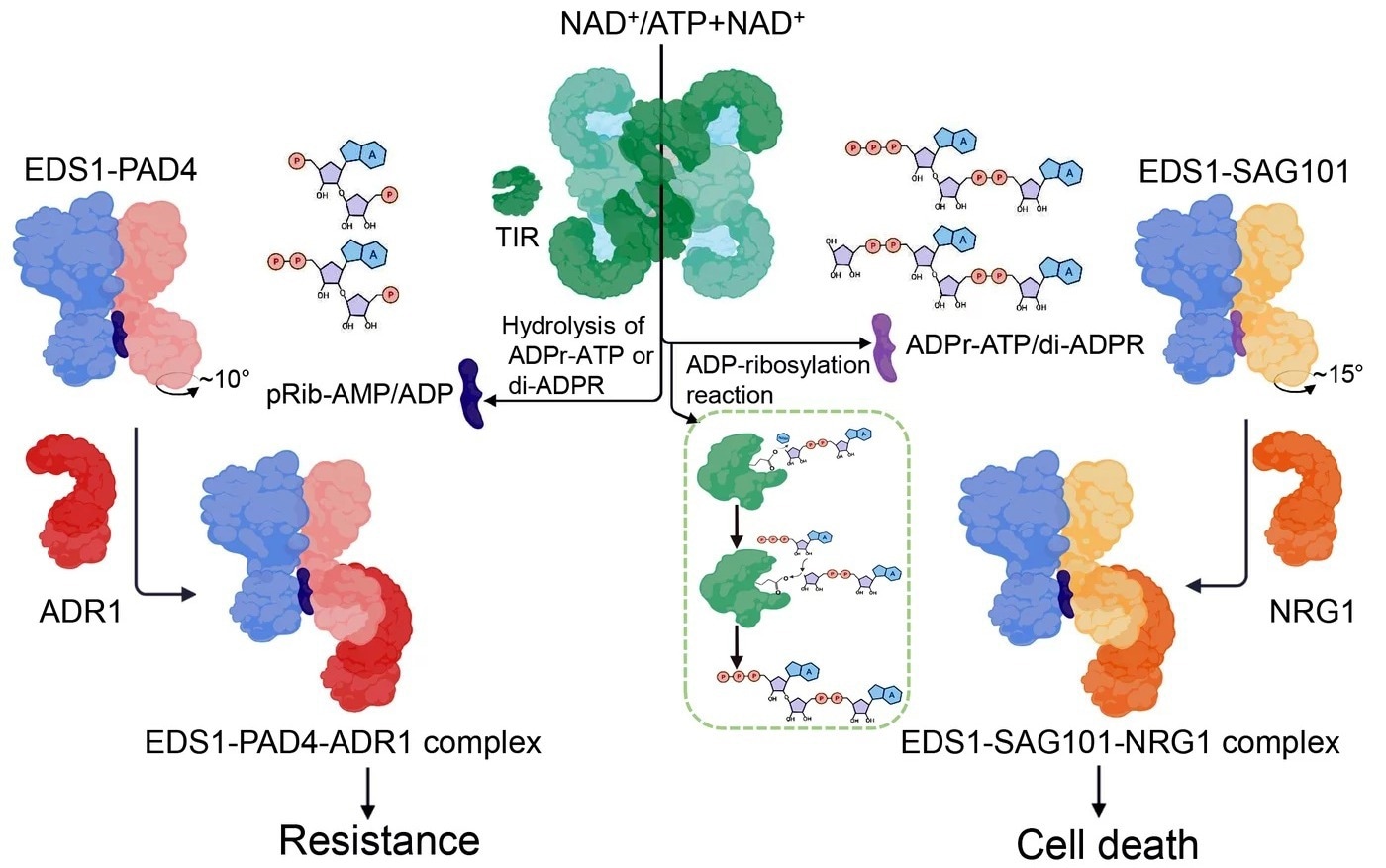Natural cellular molecules that control vital plant immune responses have been found, according to two studies conducted by scientists at the Max Planck Institute for Plant Breeding Research in Cologne, Germany, and their Chinese counterparts. These substances exhibit all the characteristics of being tiny messengers designed by plants to activate important defense-control hubs.
 Natural plant TIR-produced small molecules controlling two immunity branches. Image Credit: Max Planck Institute for Plant Breeding Research.
Natural plant TIR-produced small molecules controlling two immunity branches. Image Credit: Max Planck Institute for Plant Breeding Research.
Scientists and plant breeders may be able to build molecules that make plants, including most of the significant agricultural species, more disease-resistant by utilizing these discoveries.
By 2050, global food production must double to feed the additional two billion people who will be inhabiting the planet by that time. To improve food production, several of the staple crops must yield more.
In order to do this, policies must be put in place to make plants more resistant to tiny infectious agents and to guarantee that food production is safe for the environment. To do this, one must have a thorough grasp of the plant immune system, which refers to the defenses that plants develop in response to invading microbes.
The research team led by Jijie Chai and Jane Parker from the Max Planck Institute for Plant Breeding Research in Cologne as well as the University of Cologne, Germany, in partnership with Junbiao Chang’s team at Zhengzhou University in Zhengzhou and Zhifu Han and colleagues at Tsinghua University in Beijing, China, have now discovered two classes of molecules and established their mechanisms of action in modulating immune responses inside plant cells.
Their study opens the door for the development of bioactive small molecules that might help scientists and plant farmers increase plant tolerance to harmful microbes.
Nucleotide-binding leucine-rich repeat receptors, or NLRs for short, are proteins that play a key role in the major immunological approach used by plants. Invading microbes trigger NLRs, which then trigger defensive immune reactions. These immune responses result in the so-called hypersensitive response, which limits pathogen development and frequently causes precisely defined cell death at the infection site, analogous to amputating a toe to protect the body’s survival.
Enhanced Disease Susceptibility 1 (EDS1) has been found to receive signals from a subclass of NLR proteins known as TIR-NLRs (or TNLs), which include the so-called toll/interleukin-1 receptor (TIR) domain. Additionally, signals from smaller TIR-containing proteins activate EDS1 and increase disease resistance.
Depending on the kinds of other proteins it interacts with, EDS1 operates as a regulatory hub that directs plant cells to either stop pathogen development or go into cell death. TNL receptors and TIR proteins were previously demonstrated to be pathogen-induced enzymes. According to the available data, these TIR enzymes create a tiny messenger or messengers that communicate with EDS1 inside of cells.
The identities of the particular chemicals produced by TNLs or TIRs and responsible for activating the various immune responses, however, have remained unknown.
Parker and colleagues demonstrated that pathogen-activated TNL enzymes within plant cells may activate the two functioning EDS1 modules causing immunity or cell death.
The Chai group recreated crucial elements of the signaling pathway in insect cells, a method that permits the creation and purification of large amounts of molecules that can subsequently be separated and characterized, to discover the small molecules generated by TNLs or TIRs and that operate upon EDS1. The scientists found two distinct groups of modified nucleotide molecules made by TNLs and TIRs using this method.
Different EDS1 sub-complexes were selectively bound to and triggered by these substances. As a result, the scientists show how certain EDS1 sub-complexes identify specific TIR-produced compounds, which serve as information-carrying chemicals and stimulate immune responses.
There are numerous significant crop species, including rice and wheat that include the TIR immune receptors and the EDS1 hub proteins.
The identified TIR-catalyzed small molecules could be employed as general and natural immunostimulants to control crop diseases.”
Jijie Chai, Scientist, Max Planck Institute for Plant Breeding Research, University of Cologne
Jane Parker concludes, “knowing the biochemical modes of action of these small molecules opens a whole new chapter on plant immunity signaling and disease management.”
Source:
Journal reference:
Jia, A., et al. (2022) TIR-catalyzed ADP-ribosylation reactions produce signaling molecules for plant immunity. Science. doi.org/10.1126/scienceabq3297/8180.